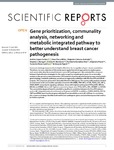Mostrar o rexistro simple do ítem
Gene prioritization, communality analysis, networking and metabolic integrated pathway to better understand breast cancer pathogenesis
| dc.contributor.author | López-Cortés, Andrés | |
| dc.contributor.author | Paz-y-Miño, César | |
| dc.contributor.author | Cabrera-Andrade, Alejandro | |
| dc.contributor.author | Barigye, Stephen J. | |
| dc.contributor.author | Munteanu, Cristian-Robert | |
| dc.contributor.author | González-Díaz, Humberto | |
| dc.contributor.author | Pazos, A. | |
| dc.contributor.author | Pérez-Castillo, Yunierkis | |
| dc.contributor.author | Tejera, Eduardo | |
| dc.date.accessioned | 2018-12-05T12:40:04Z | |
| dc.date.available | 2018-12-05T12:40:04Z | |
| dc.date.issued | 2018-11-12 | |
| dc.identifier.citation | López-Cortés A, Paz-y-Miño C, Cabrera-Andrade A, Barigye SJ, Munteanu CR, González-Díaz H, et al. Gene prioritization, communality analysis, networking and metabolic integrated pathway to better understand breast cancer pathogenesis. Sci Rep. 2018;8:16679 | es_ES |
| dc.identifier.issn | 2045-2322 | |
| dc.identifier.uri | http://hdl.handle.net/2183/21474 | |
| dc.description.abstract | [Abstract] Consensus strategy was proved to be highly efficient in the recognition of gene-disease association. Therefore, the main objective of this study was to apply theoretical approaches to explore genes and communities directly involved in breast cancer (BC) pathogenesis. We evaluated the consensus between 8 prioritization strategies for the early recognition of pathogenic genes. A communality analysis in the protein-protein interaction (PPi) network of previously selected genes was enriched with gene ontology, metabolic pathways, as well as oncogenomics validation with the OncoPPi and DRIVE projects. The consensus genes were rationally filtered to 1842 genes. The communality analysis showed an enrichment of 14 communities specially connected with ERBB, PI3K-AKT, mTOR, FOXO, p53, HIF-1, VEGF, MAPK and prolactin signaling pathways. Genes with highest ranking were TP53, ESR1, BRCA2, BRCA1 and ERBB2. Genes with highest connectivity degree were TP53, AKT1, SRC, CREBBP and EP300. The connectivity degree allowed to establish a significant correlation between the OncoPPi network and our BC integrated network conformed by 51 genes and 62 PPi. In addition, CCND1, RAD51, CDC42, YAP1 and RPA1 were functional genes with significant sensitivity score in BC cell lines. In conclusion, the consensus strategy identifies both well-known pathogenic genes and prioritized genes that need to be further explored. | es_ES |
| dc.description.sponsorship | Instituto de Salud Carlos III; PI17/01826 | es_ES |
| dc.language.iso | eng | es_ES |
| dc.publisher | Nature | es_ES |
| dc.relation.uri | https://doi.org/10.1038/s41598-018-35149-1 | es_ES |
| dc.rights | Atribución 3.0 España | es_ES |
| dc.rights.uri | http://creativecommons.org/licenses/by/3.0/es/ | * |
| dc.title | Gene prioritization, communality analysis, networking and metabolic integrated pathway to better understand breast cancer pathogenesis | es_ES |
| dc.type | info:eu-repo/semantics/article | es_ES |
| dc.rights.access | info:eu-repo/semantics/openAccess | es_ES |
| UDC.journalTitle | Scientific Reports | es_ES |
| UDC.volume | 8 | es_ES |
| UDC.startPage | 16679 | es_ES |
Ficheiros no ítem
Este ítem aparece na(s) seguinte(s) colección(s)
-
GI-RNASA - Artigos [176]
-
INIBIC-RNASA-IMEDIR - Artigos [46]







